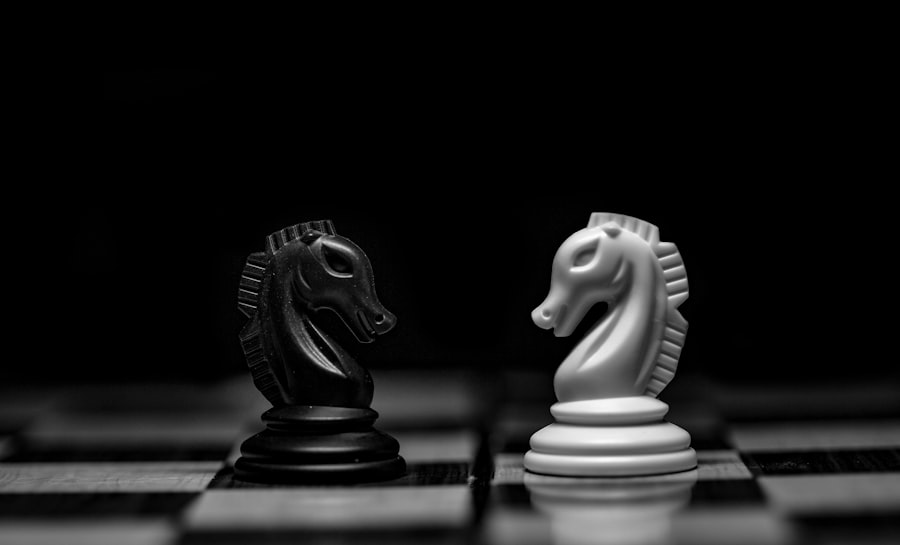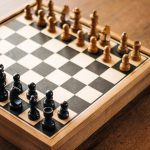Mastering Chess: Strategies for Success
Description
Chess is a strategic board game that has captivated minds for centuries, originating in India around the 6th century AD before spreading to Persia and then to Europe. At its core, chess is played between two opponents on an 8×8 grid known as a chessboard, where each player commands an army of 16 pieces: one king, one queen, two rooks, two knights, two bishops, and eight pawns. Each piece has its own unique movement rules, which dictate how it can traverse the board.
The objective of the game is to checkmate the opponent’s king, meaning the king is placed in a position where it cannot escape capture. Understanding the basic rules and movements of each piece is essential for any aspiring chess player. The king moves one square in any direction, while the queen can move any number of squares in any direction.
Rooks move horizontally or vertically, bishops move diagonally, knights have a unique L-shaped movement, and pawns move forward but capture diagonally. Additionally, players must grasp concepts such as check, checkmate, stalemate, and en passant. Familiarity with these fundamental principles lays the groundwork for more advanced strategies and tactics that will be explored later in one’s chess journey.
Key Takeaways
- Understanding the basics of chess is crucial for beginners, including learning the movement of each piece and the objective of the game.
- Developing a solid opening repertoire is essential for players to gain an early advantage and control the center of the board.
- Mastering the middle game involves strategic planning, piece coordination, and controlling key squares on the board.
- Utilizing endgame techniques is important for converting an advantage into a win, including pawn promotion and king activity.
- Improving tactical and positional skills is necessary for evaluating positions, calculating variations, and creating long-term plans.
Developing a Solid Opening Repertoire
Understanding Player Style and Preferences
For instance, aggressive players might favor openings like the King’s Gambit or the Sicilian Defense, while more positional players may lean towards the Queen’s Gambit or the Ruy Lopez.
Developing an Effective Opening Repertoire
To develop an effective opening repertoire, players should study various openings and their associated strategies. This involves not only memorizing moves but also understanding the underlying principles behind them.
Analyzing Openings and Gaining Insights
For example, in the Italian Game, after 1.e4 e5 2.Nf3 Nc6 3.Bc4, players aim to control the center while preparing for rapid piece development. By analyzing different lines and variations within these openings, players can gain insights into potential traps and tactics that may arise during play. Furthermore, practicing these openings in real games helps solidify understanding and adaptability.
Mastering the Middle Game

The middle game is often considered the most complex phase of chess, where players must navigate a myriad of tactical and strategic considerations. This stage typically begins once most pieces are developed and players have castled their kings to safety. Mastering the middle game involves recognizing patterns, formulating plans based on positional considerations, and executing tactics effectively. Players must assess their position critically, identifying strengths and weaknesses while also anticipating their opponent’s intentions. One key aspect of middle game mastery is the ability to create and exploit weaknesses in the opponent’s position.
This could involve targeting isolated pawns or weak squares that lack adequate defense. For instance, if an opponent has doubled pawns on one side of the board, a player might focus their efforts on attacking those pawns while simultaneously improving their own piece coordination. Additionally, tactical motifs such as forks, pins, and skewers become increasingly important during this phase.
Players should practice recognizing these patterns through puzzles and exercises to enhance their tactical vision.
Utilizing Endgame Techniques
| Technique | Definition | Example |
|---|---|---|
| Opposition | Placing the king directly in front of the opponent’s king to restrict its movement | King on e4 and e6, with white to move |
| Zugzwang | Forcing the opponent to make a disadvantageous move | Black is in zugzwang and must make a move that worsens their position |
| Triangulation | Wasting a move to put the opponent in a worse position | King moves in a triangular pattern to force the opponent to move |
The endgame is the final phase of a chess match where fewer pieces remain on the board. It requires a different skill set compared to the opening and middle game phases. Understanding endgame techniques is vital for converting advantages into victories or salvaging draws from inferior positions.
Key concepts include king activity, pawn promotion, and piece coordination. Players must learn how to maneuver their kings effectively while also utilizing their remaining pieces to create threats. One classic example of endgame technique is the concept of “opposition.” In king and pawn endgames, having the opposition means positioning your king directly opposite your opponent’s king with an odd number of squares between them.
This allows you to control key squares and ultimately promote your pawn to a queen. Additionally, players should familiarize themselves with fundamental checkmating patterns such as king and queen versus king or king and rook versus king. Mastery of these basic endgames can significantly improve a player’s overall performance by ensuring they can convert winning positions into victories.
Improving Tactical and Positional Skills
Tactical awareness is a cornerstone of chess proficiency. Tactics involve short-term calculations that can lead to immediate gains in material or position. Common tactical motifs include forks, discovered attacks, double attacks, and pins.
To improve tactical skills, players should engage in regular practice through puzzles and tactical exercises that challenge their ability to spot opportunities quickly. Online platforms often provide a wealth of resources for honing these skills through interactive training modules. Positional understanding complements tactical skills by focusing on long-term strategic considerations.
This involves evaluating piece activity, pawn structure, and control of key squares or files. A player with strong positional skills can make subtle improvements to their position over time, often leading to advantageous endgames or tactical opportunities later in the game. Studying classic games where positional play was paramount can provide valuable insights into how top players navigate complex positions.
Studying Grandmaster Games

One of the most effective ways to improve at chess is by studying games played by grandmasters. These elite players often demonstrate exceptional strategic understanding and tactical prowess that can serve as valuable learning tools for aspiring players. Analyzing grandmaster games allows individuals to observe how top players handle various openings, navigate through complex middle games, and execute endgame techniques with precision.
When studying grandmaster games, it is beneficial to focus on specific themes or concepts rather than merely replaying moves. For instance, one might analyze how a grandmaster capitalizes on weaknesses in their opponent’s position or how they transition from an opening into a favorable middle game setup. Additionally, many online databases provide annotated games where experienced players explain their thought processes behind each move.
This commentary can deepen understanding and provide context for strategic decisions made during play.
Managing Time and Resources
Time management is a critical aspect of chess that often goes overlooked by beginners. In tournament settings or online play with time controls, players must balance their decision-making process with the ticking clock.
Resource management extends beyond time; it also encompasses mental energy and focus during a game. Players should develop strategies for maintaining concentration throughout long matches while avoiding burnout or fatigue. Techniques such as taking short breaks between rounds or practicing mindfulness can help sustain mental clarity during intense games.
Additionally, reviewing past games to identify moments where time pressure led to mistakes can provide insights into improving future performance under similar circumstances.
Maintaining a Growth Mindset
A growth mindset is essential for continuous improvement in chess. This concept revolves around the belief that abilities can be developed through dedication and hard work rather than being fixed traits. Embracing challenges as opportunities for growth rather than obstacles fosters resilience in the face of setbacks—an inevitable part of any competitive endeavor.
Players should approach each game as a learning experience rather than solely focusing on winning or losing.
Engaging with fellow players through clubs or online communities can also provide support and motivation as individuals share experiences and insights into their own journeys in chess mastery.
By cultivating a growth mindset, players can navigate the complexities of chess with enthusiasm and determination, ultimately leading to greater success on the board.
If you are a fan of chess, you may be interested in reading about the top chess apps available on Taya365. These apps can help improve your skills and provide a challenging opponent to play against. Additionally, you may want to check out an article on how to increase your chances of winning big with the Taya365 Lottery on Taya365. This could be a fun way to test your luck and potentially win some exciting prizes.
FAQs
What is chess?
Chess is a two-player strategy board game that is played on an 8×8 grid. It is one of the most popular and enduring games in the world, with a rich history dating back over a thousand years.
How is chess played?
Chess is played on a square board divided into 64 squares, with each player starting with 16 pieces: one king, one queen, two rooks, two knights, two bishops, and eight pawns. The objective of the game is to checkmate the opponent’s king, which means putting the king into a position where it cannot escape capture.
What are the basic rules of chess?
Each type of chess piece moves in a specific way: the king moves one square in any direction, the queen moves any number of squares in any direction, the rook moves any number of squares horizontally or vertically, the bishop moves any number of squares diagonally, the knight moves in an L-shape, and the pawn moves forward one square and captures diagonally. The game ends when a player’s king is in checkmate, or when a stalemate is reached.
What are the benefits of playing chess?
Chess has been shown to have numerous cognitive benefits, including improving memory, concentration, problem-solving skills, and strategic thinking. It is also a great way to improve patience and decision-making abilities.
What is the history of chess?
Chess is believed to have originated in India around the 6th century, and it spread to Persia, where it became known as “shatranj.” It then made its way to Europe and evolved into the game we know today. Chess has a rich and storied history, with many famous players and memorable matches throughout the centuries.





